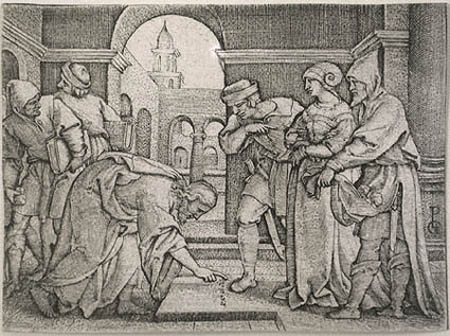| Title: |
Christ and the Adulterous Woman |
| Artist: |
Pencz, Georg (Nuremberg, C. 1500 - Breslau, 1550) |
| Date: |
c. 1540 |
| Medium: |
Original Engraving |
| Note: |
Georg Pencz: Generally regarded as one of the greatest
original engravers of his time, Georg Pencz was admitted into the illustrious
Nuremberg Guild of Artists in 1523, after he had served his apprenticeship
under none other than Albrecht Durer. Pencz, in fact, is the only known
student of Durer. Although his first commissioned works of art were paintings,
Georg Pencz came into close contact in this decade with the brothers, Barthel
Beham and Hans Sebald Beham. Together, these three talented engravers
would come to be known to history as the 'Little Masters', so named because
all three created incomparable miniature engravings on a scale such as
this original example. |
| |
Georg Pencz lived in tumultuous times. Sparked by the resistance
of Martin Luther and his followers, religious struggles were at the forefront.
Along with several other prominent artists and writers, Georg Pencz was accused
of 'heresy' and was banished from Nuremberg in 1524. Far from it adversely
affecting his art, the sentence gave Georg Pencz the opportunity to travel
widely, particularly in Italy. There, Pencz came under the powerful influence
of the Italian Renaissance, most notably the designs of Raphael and the
engraving school of Marc-Antonio Raimondi. It is speculated that he created
his first engraving there in 1535. Shortly thereafter Georg Pencz returned to
Germany and in the following fifteen year span produced an outstanding
oeuvre of over one hundred miniature engravings, most dealing with scenes
from the Old and New Testaments and from classical mythology. |
| |
More than any other artist, Georg Pencz successfully amalgamated
the best elements of Northern and Southern Renaissance art. Christ
and the Adulterous Woman serves as a prime example, for in the little
masterpiece one can easily detect the psychological tensions so dominant
in German art, with the grace and beauty of classical Italian art. Only
a true Renaissance master such as Georg Pencz could accomplish all the marvels
of movement combined with the sense of architectural space in such an
amazingly small surface. |
| Raisonne: |
The Illustrated Bartsch, Volume 16. Catalogue # 55, First and Only State. |
| |
T. Falk, ed., Hollstein's German Engravings, Etchings
and Woodcuts 1400-1700, Amsterdam, Koninklijke van Poll, 1991. |
| |
Catalogue # 33, First and Only State. |
| Size: |
2 1/2 X 3 1/4 (Sizes in inches are approximate,
height preceding width of plate-mark or image.) |
| |
Framed and Matted with 100% Archival Materials |
| Condition: |
Trimmed to the margins, as usual. Printed on mid sixteenth
century hand-made paper. One very slight stain exists on the leg of the
man immediately to the left of Christ, else in excellent condition throughout.
A strongly printed, early impression and a magnificent example of the
engraved work of this great German master of the Renaissance, Georg Pencz. |
| Price: |
Sold - The price is no longer available. |
| Important Information: |
The artist biographies, research and or information pertaining to all the original works of art posted on our pages has been written and designed by Greg & Connie Peters exclusively for our site, (www.artoftheprint.com). Please visit us regularly to view the latest artworks offered for sale. We will soon be posting an update of our most recent research and include the biographical and historical information pertaining to our next collection of original works of art created by artists throughout the centuries. We hope you found the information you were looking for and that it has been beneficial.
Our Gallery, (Art of the Print / www.artoftheprint.com) guarantees the authenticity of every work of art we sell 100%. Full documentation and certification is provided. We offer a wide selection of international fine art dating from the early Renaissance to the contemporary art period. |







![]()
![]() or
phone Greg & Connie (905) 957-6666
or
phone Greg & Connie (905) 957-6666